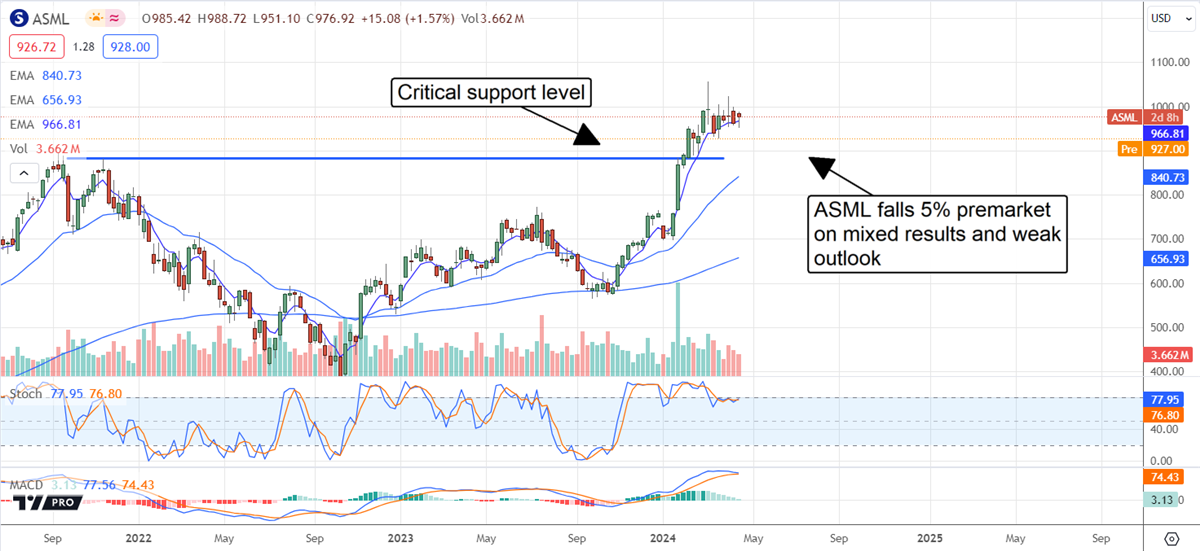- ASML had a weak quarter, characterized by disappointing new orders that contradicted existing guidance.
- Although ASML maintains its guidance, it anticipates a significant improvement in the latter half of the year, a feat that may prove elusive.
- While cash flow remains robust and the balance sheet healthy, indicating a potential buy-the-dip opportunity, the dip is not yet over, and further price declines are looming.
ASML struggled in Q1, sending a cautionary signal to semiconductor investors. The lackluster performance in new orders fell short of projections and cast doubts on the overall semiconductor industry forecast. Even with a notable portion of new orders featuring cutting-edge EUV technology, it was insufficient to sustain the lofty expectations fueled by AI advancement.
This shortfall suggests that the outcomes for chipmakers could fall below anticipated levels in the future. On top of that, weaker guidance could usher the tech sector into a severe downturn. Leading stocks like Advanced Micro Devices and NVIDIA have witnessed declines from their peaks, though they remain considerably higher than last year, leaving them in a vulnerable state. Companies closely associated with ASML’s business such as Intel, Taiwan Semiconductor, and Samsung also face the prospect of extending their recent descent.
ASML Encounters Weak Quarter But Confirms Guidance
ASML’s performance in Q1 was lackluster, with revenue plunging by 21% compared to the previous year due to underperformance in both new and used equipment sales. New equipment sales saw a 42% decline, while used equipment sales plummeted by 64%. Despite a decent Q2 guidance with projected sequential growth, the impact of net bookings marred any positive outcomes. Net bookings nosedived by 60% sequentially, reflecting cautious sentiments among chipmakers.
The margin remained steady, experiencing a marginal 40 basis points decline, surpassing expectations and bolstering better-than-expected bottom-line results. The GAAP of $3.31 exceeded the consensus by $0.40, although direct comparability may be affected by FX translation. The results were substantially impressive to sustain dividend payments and foster dividend growth, with the board declaring a final payment for 2023 equivalent to $1.86 against the current $1.06.
Despite decent guidance, a significant surge in the latter half of the year may fall short. Q2 revenue is expected to climb to $6.07 to $6.6 billion, with stronger outcomes anticipated in the later part of the year. The full-year outlook remains no higher than the previous year, cautioning that 2024 will be a year of transition. The company anticipates a resurgence in growth by 2025, driven by next-gen and AI technologies supported by initiatives like the CHIPs Act in the US and global demand.
ASML Capital Returns Remain Steady
ASML’s dividend yield is moderate, with payouts occasionally erratic due to distribution policies, but they are secure and dependable. The company channels less than 35% of its earnings towards dividends, maintaining a robust balance sheet.
Notable balance sheet highlights from Q1 include a decrease in cash and assets countered by reduced debt and liabilities, leading to a rise in shareholder equity. With leverage of under 0.35x equity, total liabilities less than 2x equities, and cash reserves about 5x, the company possesses the strength in cash flow and balance sheet to support share repurchases. However, despite these buybacks, dilutive actions over the past year have resulted in a rise in share count.
Although analysts support this market, as evidenced by the rise in price targets, upgrades, and initiated coverages in 2024, prospects may be capped following the release of results and guidance. The consensus, showing a 33% increase from last year, suggests a 5% upside pre-release and a 10% post-release decline, amidst doubts of further upward momentum.
ASML Battles Resistance: Potential for Further Declines
Following the Q1 release, ASML stocks tumbled by 5% in premarket trading, signaling strong resistance at recent highs and a potential market reversal. Crucial support resides near earlier peaks at $885 and may face a stern test soon. Failure to maintain support at this level could drive the market down towards $800 or below, conceiving a value-oriented opportunity and setting the stage for strategic investments. The key question lingers on when the rebound in equipment sales will gather momentum.






